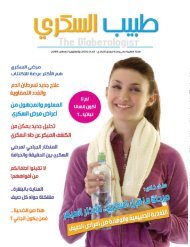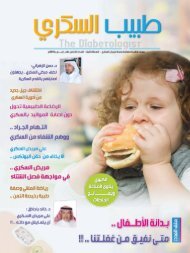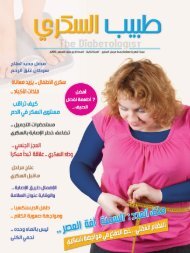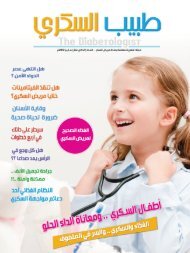The Diabetologist #24+25
طبيب السكري - العدد 24+25
طبيب السكري - العدد 24+25
You also want an ePaper? Increase the reach of your titles
YUMPU automatically turns print PDFs into web optimized ePapers that Google loves.
a food insulin index, a physiological basis for ranking<br />
foods according to insulin demand for 120 single<br />
foods.67<strong>The</strong>y concluded that the relative insulin<br />
demand evoked by mixed meals consumed by lean<br />
healthy subjects is best predicted by a physiological<br />
index (food insulin index) based on integrating insulin<br />
responses to isoenergetic portions of single foods.<br />
Eating patterns that provoke less insulin secretion<br />
may be helpful in managing diabetes. In 2011, another<br />
Australian study compared a novel algorithm based<br />
on the food insulin index for estimating mealtime insulin<br />
dose to carbohydrate counting in T1D adults using<br />
CSII.68 <strong>The</strong> study concluded that, when compared<br />
with carbohydrate counting, the food insulin index<br />
algorithm improved acute postprandial glycemia in<br />
well-controlled T1D subjects. <strong>The</strong> authors acknowledge<br />
that clinical application of these findings is not<br />
currently feasible, since the food insulin index does<br />
not presently appear on food labels and the food insulin<br />
index database includes only ~120 foods.12<br />
Another group collected data on food intake, physical<br />
activity, insulin administration, and blood glucose<br />
test results in T1D patients using self-administered<br />
questionnaires.69Sixty-four percent of the participants<br />
incorrectly estimated their prandial insulin, revealing<br />
that optimal prandial insulin dosing is not easy and requires<br />
continuous assessment and related education<br />
and support, even after a long duration of diabetes.12<br />
Insulin dosing aids such as bolus insulin calculation<br />
cards and dosing guides have been developed to<br />
reduce potential calculation errors.70–72 Bolus calculators<br />
with personalized insulin-dosing algorithms<br />
can be programmed in a wide range of devices, such<br />
as personal digital assistants (PDAs), smartphone<br />
applications, or insulin pumps.12,73,74<br />
<strong>The</strong> Diabetes Interactive Diary is an automatic carbohydrate<br />
and insulin bolus calculator installed on<br />
a mobile phone, using patient-physician communication<br />
via text messages. When compared with<br />
a standard carbohydrate-counting education program,<br />
the Diabetes Interactive Diary was as effective<br />
as a traditional carbohydrate-counting education<br />
program, without an increased hypoglycemia<br />
risk.75 Technology has reduced education time<br />
while significantly improving treatment satisfaction<br />
and several quality-of-life dimensions. Adaptive<br />
aids are popular with the tech-savvy but may be<br />
useful for those with health literacy and numeracy<br />
concerns, such as young children or adults who<br />
cannot perform complex mathematical equations<br />
required for intensive insulin therapy.76Technology<br />
may allow more people with insulin-requiring diabetes<br />
to have access to diabetes self-management<br />
tools, education, and support.12<br />
Factors that May Affect Long-Term<br />
Adherence to Carbohydrate Counting<br />
Three studies have explored the food and eating<br />
practices of T1D subjects who converted to flexible<br />
intensive insulin therapy (FIIT) as part of the DAFNE<br />
course.5,16,77Ironically, in efforts to simplify food<br />
choices for easier carbohydrate estimation, patients<br />
may rely on prepackaged foods, with higher saturated<br />
fats and salt, but with nutrition labels, rather<br />
than calculate the carbohydrate content for fresh<br />
fruits, vegetables, and other unprocessed items that<br />
do not have food labels. FIIT participants also expressed<br />
anxieties about miscalculating carbohydrate<br />
amounts and injecting the wrong dose. This caused<br />
participants to eat the same foods repeatedly, limiting<br />
intake of new foods or foods with difficult-todetermine<br />
carbohydrate content. Some participants<br />
intentionally choose low- or no-carbohydrate foods<br />
to simplify prandial dose calculations. Despite formal<br />
intensive insulin therapy classes, many subjects<br />
feared hypoglycemia when matching mealtime insulin<br />
to desired food (carbohydrate) intake.5 <strong>The</strong>se<br />
data raise factors that need to be addressed during<br />
initial and ongoing nutrition therapy. Strategies<br />
are needed to successfully sustain this therapy on a<br />
daily basis.12,77<br />
One study interviewed DAFNE program participants<br />
at 6 weeks and 6 and 12 months on assimilating<br />
course principles.16 Subjects initially (6 weeks) felt<br />
support from other participants, for example, by sharing<br />
experiences. However, after 6 months, subjects<br />
valued support from responsive health care professionals<br />
that focused on collaborative decision making.<br />
<strong>The</strong> investigators concluded that diabetes educators<br />
must clearly communicate to participants that<br />
FIIT principles take time (perhaps over 12 months).<br />
Support at 6 months appeared to be an important<br />
timeframe for subjects, since motivation at this point<br />
was lowest for many.12<br />
People with insulin-requiring diabetes may also diligently<br />
perform dose calculations using their individualized<br />
algorithms when beginning intensive insulin<br />
therapy.73 However, adherence to the ongoing determination<br />
of the prandial insulin dose may become<br />
relaxed as the individual with diabetes gains familiarity<br />
with the self-adjustment of the insulin. As time passes,<br />
there may be the tendency to begin to approximate<br />
premeal doses by titrating insulin based on the standard<br />
or usual carbohydrate content of the meal. In addition,<br />
many people with insulin-requiring diabetes<br />
may actually be hesitant to take on the responsibility<br />
of increasing or decreasing their insulin doses on the<br />
basis of their carbohydrate intake and premeal blood<br />
glucose level.12,73<br />
04<br />
issue 24 - 25 < SEP./OCT. 2013

















